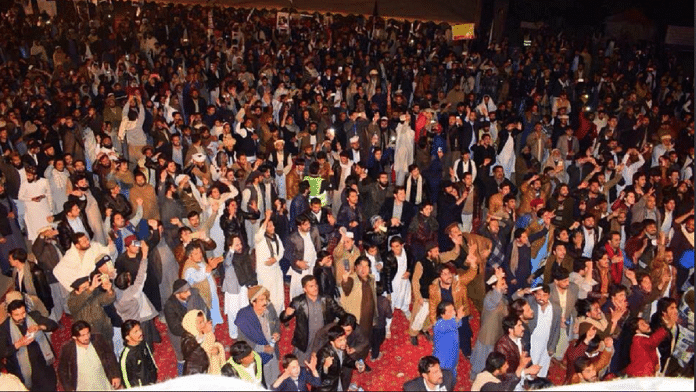The first large protest by the Pashtuns for their rights had become a rage on social media and across the political divide.
It is now obvious the long suffering ethnic Pashtuns (or Pakhtuns, Pathans) from the Federally Administered Tribal Areas (FATA), bordering Afghanistan, were waiting for an opportunity to vent their grievances and aspirations.
The extrajudicial killing of 27-year-old Naqeebullah Mehsud, an aspiring model hailing from FATA’s South Waziristan Agency, in a fake ‘police encounter’ in Karachi on 13 January served as the trigger for launching a campaign to seek justice not only for Naqeebullah, but also other Pashtuns killed in such dubious gun-battles with the cops.
The protestors, including women, something unusual for Pashtuns, added other demands to the list as their campaign strengthened across the country. They demanded an end to enforced disappearances and recovery of the so-called ‘missing persons’, who are allegedly seized by security agencies on the basis of suspicion that they are militants or facilitators.
Other demands included payment of compensation to the victims of militancy and military operations, ending harassment of the tribal people at security checkpoints, and the removal of landmines and improvised explosive devices (IEDs) that are taking a heavy toll on internally displaced persons returning home to areas cleared of militants in South Waziristan and other parts of FATA.
The protest campaign by the Mehsud tribe of Pashtuns began in Karachi’s Sohrab Goth locality, where Naqeebullah was killed along with three others on the orders of senior police officer Rao Anwar Ahmed Khan, who has earned notoriety as an ‘encounter specialist’ owing to his frequent claims of killing ‘terrorists’ and criminals in encounters with the police. The protests soon reached Tank and Dera Ismail Khan in Khyber Pakhtunkhwa province, where the Mehsuds live in large numbers, adjacent to their ancestral villages in South Waziristan.
Eight young Mehsud students from the Gomal University in Dera Ismail Khan launched the Mehsud Tahaffuz Movement for the protection of fellow tribespeople, and began a ‘long march’ to Peshawar on the way to Islamabad. The procession grew in numbers and enthusiasm as it reached the federal capital and camped outside the Islamabad Press Club. This was the beginning of the protest sit-in, or ‘dharna’ as such gatherings have come to be known in recent years in Pakistan.
As the protest gathered steam, attracting 5,000 to 6,000 people daily and becoming a rage on social media, it came to be known as the ‘Pashtun Long March’, and attracted Pashtuns from not only Mehsud and other tribes in FATA, but also from Khyber Pakhtunkhwa, Balochistan and Sindh provinces. Participants at the dharna came from across the political divide and listened to emotional speeches by Pashtun nationalists, civil society activists and members of the intelligentsia highlighting the suffering of the Pashtun people. Poets joined the protest and Pashto music and patriotic songs filled the air.
This was the first time that Pashtuns had protested specifically for their rights in Islamabad. Despite their reputation for being emotional and combative, the protesting Pashtuns remained peaceful and disciplined. The protest campaign wasn’t led by any political party or leader. Instead, the All Pakistan Qaumi Jirga was hastily formed by the organisers to lead the protest. Almost all political parties backed the campaign and sent their top leaders to address the protestors, because they realised the potential for attracting votes ahead of the general election scheduled to be held in July.
The dharna ended on the 10th day, Saturday, after assurances from the government that Naqeebullah’s killers would be brought to justice, South Waziristan and rest of FATA would be cleared of landmines through 10 demining teams made available by the Pakistan Army, and victims of violence would be compensated. Prime Minister Shahid Khaqan Abbasi had earlier received a delegation of the protestors and sent his advisor Amir Muqam, an ethnic Pashtun, to assure the gathering that arresting the absconding senior cop Rao Anwar was the responsibility of the state and all resources would be used to apprehend and punish him. The protest organisers gave 30 days to the government to implement its promises, and warned that the dharna would resume if their demands weren’t fulfilled.
The Pashtun Long March had already made headlines in the international media, but Afghan President Ashraf Ghani’s support to the Pashtun protestors gave it another dimension in the backdrop of the deteriorating relations between Afghanistan and Pakistan. Many Pakistanis termed Ghani’s intervention in an internal issue concerning Pakistan as perplexing. They advised him to focus on tackling serious internal issues, including ethnic divisions, facing Afghanistan. Certain Pakistani Pashtun nationalists drew comfort from the fact that the issues of suffering and well-being of Pashtuns cannot remain confined to Pakistan as they live on both sides of the Durand Line dividing the two countries.
Though the dharna has ended, the issues that formed the reason for the protest campaign remain to be resolved. The biggest challenge for the government is to arrest Rao Anwar, who has gone into hiding after trying unsuccessfully to flee the country by taking a flight out of Islamabad. If he isn’t arrested and the landmines buried under the earth in Waziristan continue to kill and maim people, the tribespeople could return to Islamabad to re-launch their protest campaign, as they have now learnt how to make their voices heard.
Rahimullah Yusufzai is Resident Editor of the English daily The News International in Peshawar







The cop isn’t free. He’s hiding from the authorities. Those are two very different things.